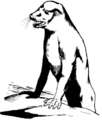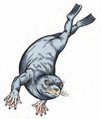Selkie
 | This article or section is about Monstergirls (or a monster that is frequently depicted as a Monstergirl), something that /tg/ widely considers to be the purest form of awesome. Expect PROMOTIONS! and /d/elight in equal measure, often with drawfaggotry or writefaggotry to match. |

The Selkie is an oceanic fae therianthrope native to the mythology of Scotland and Ireland (one of the many things they share in common). In a nutshell, selkies are a race of fae who spend most of their existence in the form of seals, wandering the ocean and doing seal things, but every so often, they come onto land and take human form. Their precise relationship with the Finfolk, the oft-malevolent undersea faeries of those islands, varies depending on the legend and which region of the isles you actually visit.
Selkies fit into the "animal lover" archetype of therianthropy, using an enchanted seal pelt to assume their sea-going form and slipping it off like a coat when they want to walk amongst humans. Their most common reason for doing this, as you'd expect, is to find some pleasure with human partners - who often steal the pelt in order to trap the selkie in human form and marry them, something that invariably backfires. Unusually, most selkie stories of this kind revolve around male selkies who come for human loving and often fall afoul of the wiles of love-struck human maidens; the reverse, where a human man tries to wed a female selkie, does happen, but it's far from the universal status of similar critters - rather like the Boto, a shapeshifting male river dolphin from the Amazon River.
Children of humans and selkies are usually described as being both drawn to the sea and very good at swimming, which you'd kind of expect. Webbed fingers are also prominent.
Selkies appeared in the early days of Dungeons & Dragons, first appearing in the Monster Manual II, then reappearing in 2e Advanced Dungeons & Dragons in the Monstrous Compendium Volume One and Monstrous Manual. Their last appearance to date remains the Fiend Folio for 3rd edition, although a 3.5 "Dread Selkie" appeared in the Ravenloft netbook "Quoth The Raven #20", alongside a Half-Selkie racial template. Ordinary selkies are a benevolent-leaning neutral, rather like merfolk, whilst Dread Selkies are a more malevolently self-centered version.
Pathfinder, meanwhile, features Selkies in "Night of Frozen Shadows", the second part of its Jade Regent adventure path. The Golarion selkie is a vicious, mischievous and oft-malicious shapeshifting predator, not that dissimilar in many ways from the D&D Seawolf. It was later reprinted in the Bestiary 4.
Selkie PCs[edit]
Like a number of other underwater humanoids, both mainstream and obscure, selkies received a PC writeup for Advanced Dungeons & Dragons 2nd edition in the article "Heroes of the Sea" in Dragon Magazine #250. Other benefactors of this treatment included crabfolk, koalinths, locathah, malenti, merfolk, pahari, and vodyanoi, alongside the new "Liminals" race - descendants of humans and merfolk.
In this source, it is stated that PC selkies come from the unusual minority of their kind who can transform at will and maintain the transformation indefinitely. Most adventure out of curiosity about the surface world, but others are "crusaders" motivated by perceived threats and injustices done to the ocean.
- Ability Score Minimum/Maximum: Strength 3/17, Dexterity 3/18, Constitution 3/18, Intelligence 8/18, Wisdom 6/18, Charisma 8/18
- Ability Score Adjustments: +1 Charisma, -1 Strength
- Racial Class & Level Limits: Fighter 8, Ranger 8, Mage 10, Shaman 5, Bard 12
- Available Kits: Sellsword, Tribal Defender, Wilderness Protector, Hedge Wizard, Humanoid Scholar
- Multiclassing: Fighter/Mage, Fighter/Shaman, Ranger/Shaman
- Natural Armor Class: 10 in human form, 5 in Selkie form
- Special Advantages: Selkies in their true form have a swim rate of 36, suffer no movement or attack penalties when in water, receive Swimming as a bonus proficiency, and can hold their breath for 45 + (Con score * 2) minutes. The modifiers for holding one's breath are taken from the Constitution-based addition to this time, not the base 45 minutes.
- Special Disadvantages:
- Roleplaying Disadvantage: Selkies may be mistaken for a breed of therianthrope, such as a Seawolf.
- At 1st level, a selkie receives only half its normal weapon proficiency slots for its class, although kit-based bonus proficiencies are unaffected.
- Weapon Proficiencies: Sword, Trident, Harpoon, Cutlass
- Nonweapon Proficiencies: Natural Fighting, Navigation, Poetry, Singing, Storytelling, Weather Sense
Like the Malenti, despite clearly giving the selkie levels in Ranger, the article then contradicts that instead selkies are restricted to "pseudo-rangers" - fighters with the Wilderness Protector kit. Also like malenti, selkie wilderness protectors lose Tracking and swap Survival (Woodlands) for Survival (Aquatic). Furthermore, it claims they can't actually be true bards, but instead are Thieves with the Humanoid Bard kit.
Gallery[edit]
-
-
-
-
Pathfinder
-
The MGE takes a rather unusual approach to the selkie's seal skin.
| The Therianthropes of Dungeons & Dragons | |
|---|---|
| Therianthrope | Laridian • Loup-garou • Loup du Noir • Lythari • Red Falcon • Seawolf • Selkie • Shifter • Swanmay • Thebestyn • Vodoni • Werebaboon • Werebadger • Werebat • Werebear • Wereboar • Werecat • Werecrocodile • Werefox • Werehyena • Werejackal • Werejaguar • Werekillerwhale • Wereleopard • Werelion • Werepanther • Wererat • Wereraven • Wereray • Wereseal • Weresnake • Wereshark • Werespider • Wereswine • Weretiger • Werewalrus • Werewolf |
| Antherions | Aranea • Song Dragon • Jackalwere • Nawidnehr • Wolfwere |
| Third Party | Werealligator • Wereanaconda • Werebunny • Werecheetah • Werecobra • Weremustela • Wereoctopus • Werepossum • Wereraccoon • Werestag • Werewolverine |




